Pharmacology Assignment: Evaluation of Drug Scheme for Stomach Ulcers
VerifiedAdded on 2020/05/01
|7
|1218
|70
Report
AI Summary
This pharmacology assignment report focuses on stomach ulcers, detailing their causes, symptoms, and diagnostic methods. It explores the role of gastric acid, pepsin, and Helicobacter pylori in ulcer formation. The report examines various drug treatments, including antacids, antibiotics, H2-receptor antagonists, prostaglandins, bismuth subsalicylate, and proton pump inhibitors (PPIs). It highlights the mechanism of action of PPIs, their effectiveness in reducing acid secretion, and their chemical structure. The report also discusses the potential side effects of reduced gastric acid and concludes that PPIs are a highly effective treatment option due to their irreversible binding to the gastric proton pump. References are included to support the information presented.
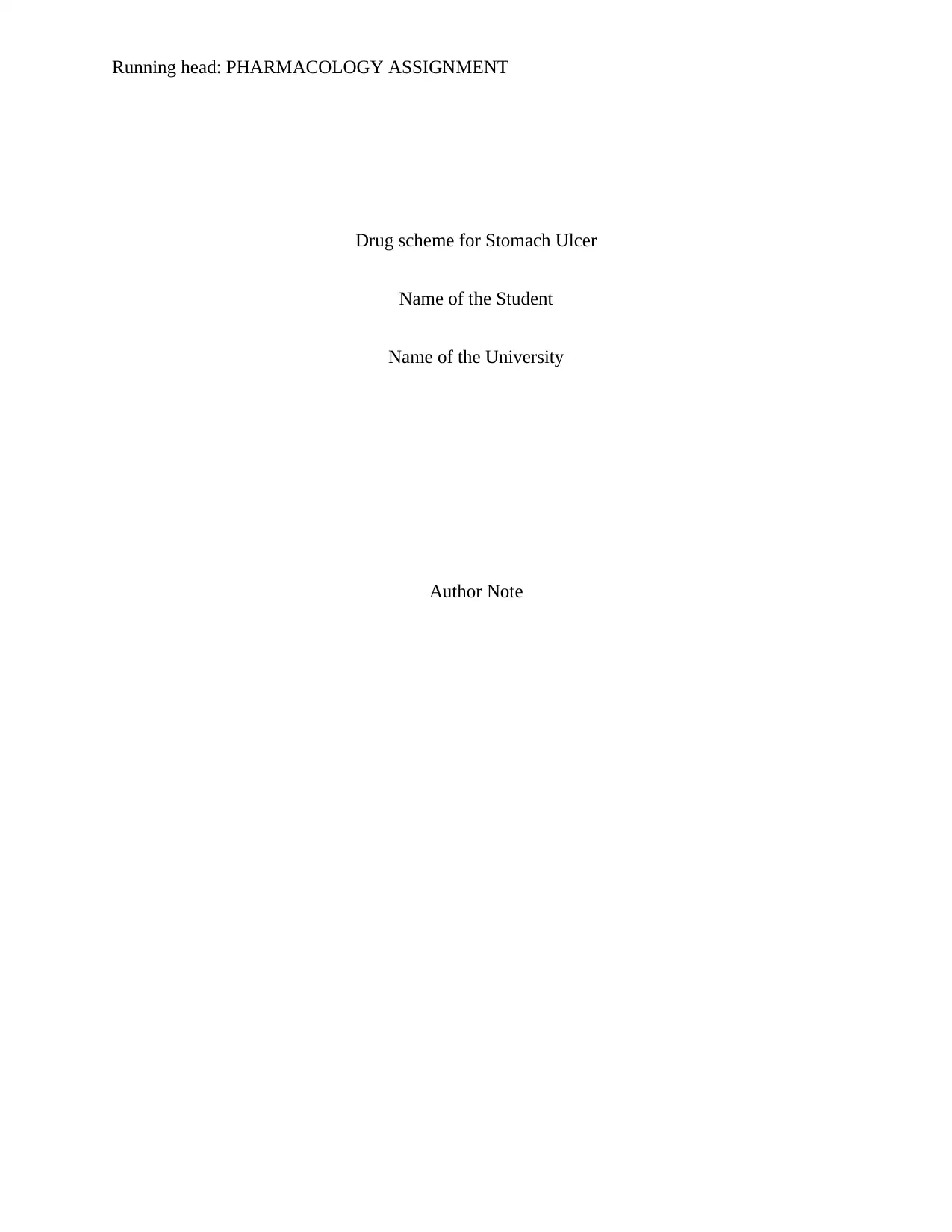
Running head: PHARMACOLOGY ASSIGNMENT
Drug scheme for Stomach Ulcer
Name of the Student
Name of the University
Author Note
Drug scheme for Stomach Ulcer
Name of the Student
Name of the University
Author Note
Paraphrase This Document
Need a fresh take? Get an instant paraphrase of this document with our AI Paraphraser
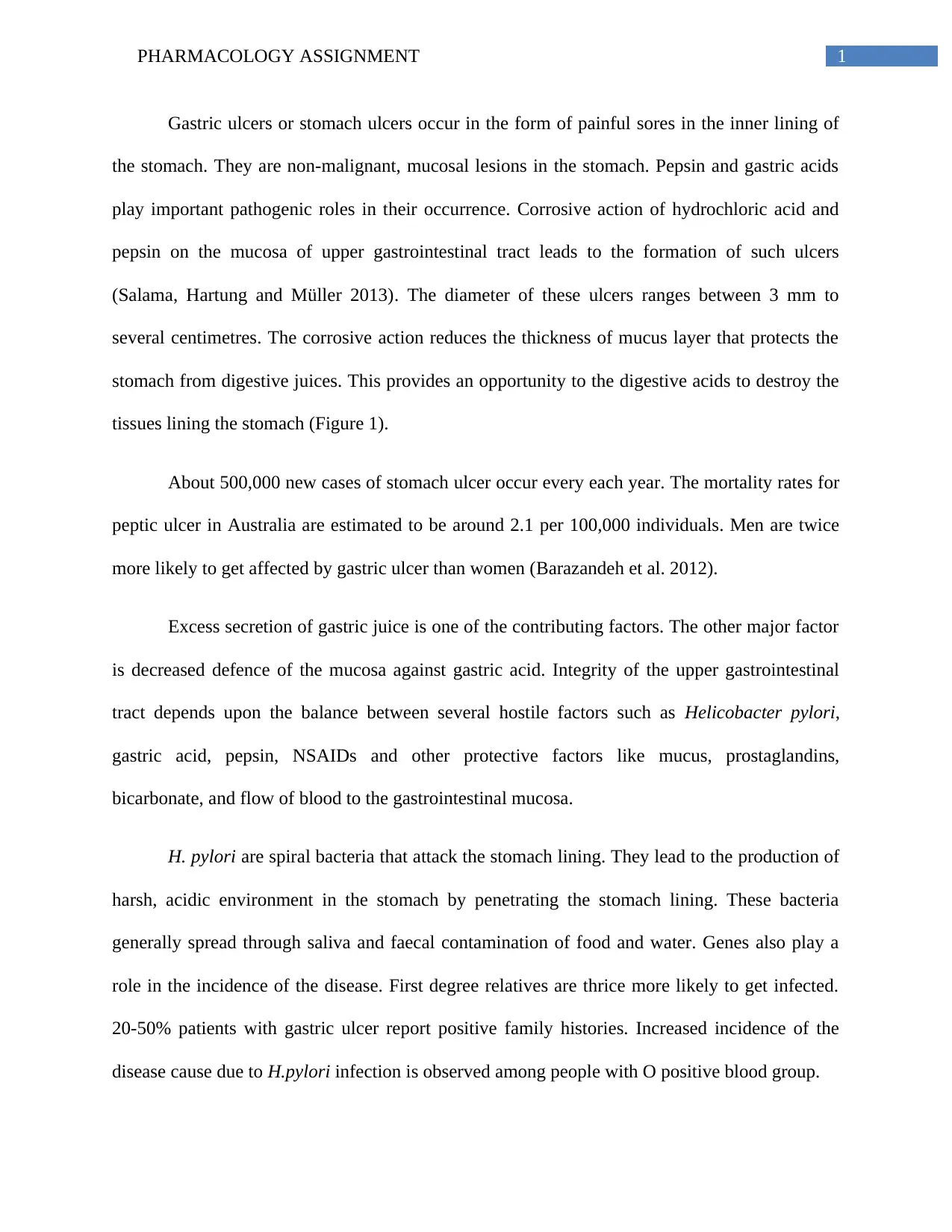
1PHARMACOLOGY ASSIGNMENT
Gastric ulcers or stomach ulcers occur in the form of painful sores in the inner lining of
the stomach. They are non-malignant, mucosal lesions in the stomach. Pepsin and gastric acids
play important pathogenic roles in their occurrence. Corrosive action of hydrochloric acid and
pepsin on the mucosa of upper gastrointestinal tract leads to the formation of such ulcers
(Salama, Hartung and Müller 2013). The diameter of these ulcers ranges between 3 mm to
several centimetres. The corrosive action reduces the thickness of mucus layer that protects the
stomach from digestive juices. This provides an opportunity to the digestive acids to destroy the
tissues lining the stomach (Figure 1).
About 500,000 new cases of stomach ulcer occur every each year. The mortality rates for
peptic ulcer in Australia are estimated to be around 2.1 per 100,000 individuals. Men are twice
more likely to get affected by gastric ulcer than women (Barazandeh et al. 2012).
Excess secretion of gastric juice is one of the contributing factors. The other major factor
is decreased defence of the mucosa against gastric acid. Integrity of the upper gastrointestinal
tract depends upon the balance between several hostile factors such as Helicobacter pylori,
gastric acid, pepsin, NSAIDs and other protective factors like mucus, prostaglandins,
bicarbonate, and flow of blood to the gastrointestinal mucosa.
H. pylori are spiral bacteria that attack the stomach lining. They lead to the production of
harsh, acidic environment in the stomach by penetrating the stomach lining. These bacteria
generally spread through saliva and faecal contamination of food and water. Genes also play a
role in the incidence of the disease. First degree relatives are thrice more likely to get infected.
20-50% patients with gastric ulcer report positive family histories. Increased incidence of the
disease cause due to H.pylori infection is observed among people with O positive blood group.
Gastric ulcers or stomach ulcers occur in the form of painful sores in the inner lining of
the stomach. They are non-malignant, mucosal lesions in the stomach. Pepsin and gastric acids
play important pathogenic roles in their occurrence. Corrosive action of hydrochloric acid and
pepsin on the mucosa of upper gastrointestinal tract leads to the formation of such ulcers
(Salama, Hartung and Müller 2013). The diameter of these ulcers ranges between 3 mm to
several centimetres. The corrosive action reduces the thickness of mucus layer that protects the
stomach from digestive juices. This provides an opportunity to the digestive acids to destroy the
tissues lining the stomach (Figure 1).
About 500,000 new cases of stomach ulcer occur every each year. The mortality rates for
peptic ulcer in Australia are estimated to be around 2.1 per 100,000 individuals. Men are twice
more likely to get affected by gastric ulcer than women (Barazandeh et al. 2012).
Excess secretion of gastric juice is one of the contributing factors. The other major factor
is decreased defence of the mucosa against gastric acid. Integrity of the upper gastrointestinal
tract depends upon the balance between several hostile factors such as Helicobacter pylori,
gastric acid, pepsin, NSAIDs and other protective factors like mucus, prostaglandins,
bicarbonate, and flow of blood to the gastrointestinal mucosa.
H. pylori are spiral bacteria that attack the stomach lining. They lead to the production of
harsh, acidic environment in the stomach by penetrating the stomach lining. These bacteria
generally spread through saliva and faecal contamination of food and water. Genes also play a
role in the incidence of the disease. First degree relatives are thrice more likely to get infected.
20-50% patients with gastric ulcer report positive family histories. Increased incidence of the
disease cause due to H.pylori infection is observed among people with O positive blood group.
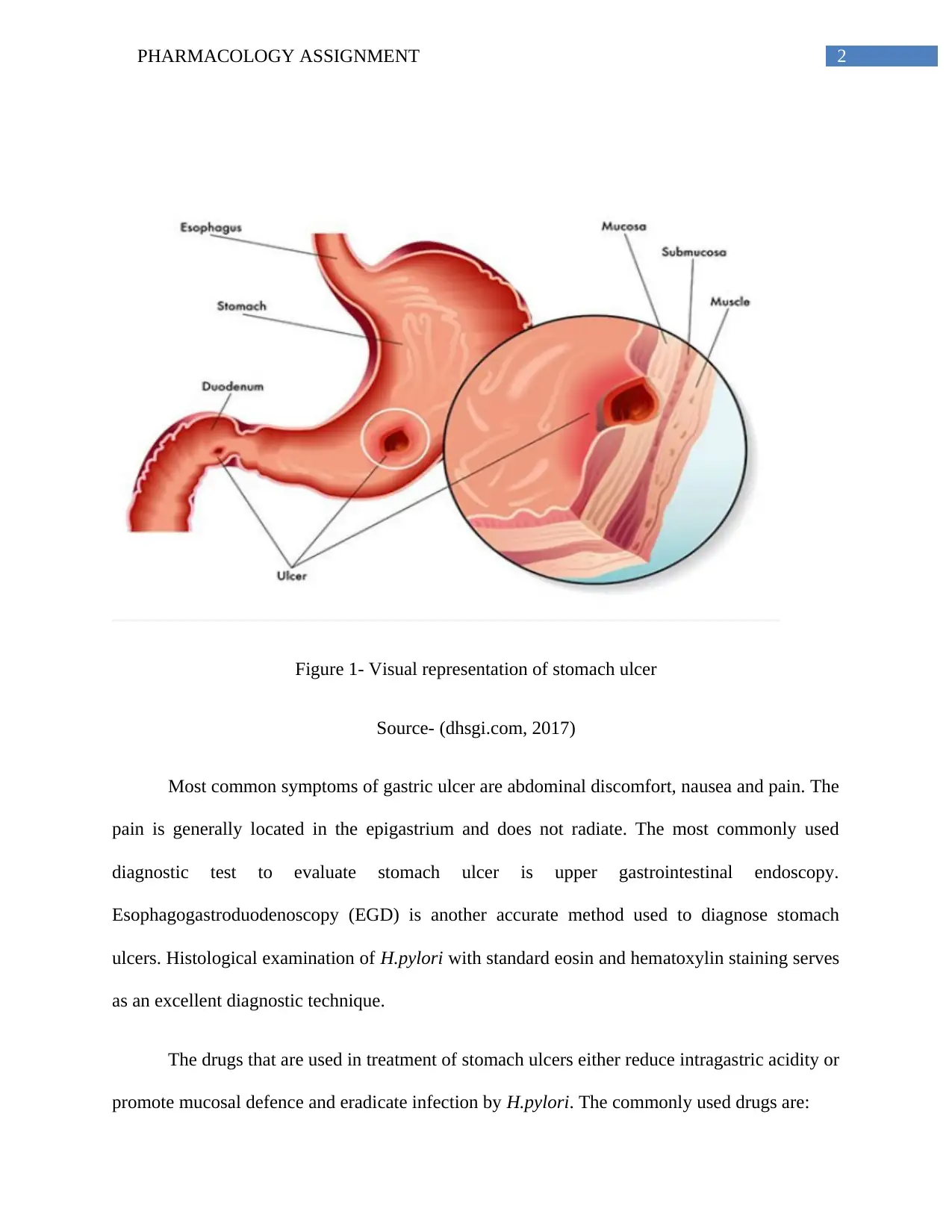
2PHARMACOLOGY ASSIGNMENT
Figure 1- Visual representation of stomach ulcer
Source- (dhsgi.com, 2017)
Most common symptoms of gastric ulcer are abdominal discomfort, nausea and pain. The
pain is generally located in the epigastrium and does not radiate. The most commonly used
diagnostic test to evaluate stomach ulcer is upper gastrointestinal endoscopy.
Esophagogastroduodenoscopy (EGD) is another accurate method used to diagnose stomach
ulcers. Histological examination of H.pylori with standard eosin and hematoxylin staining serves
as an excellent diagnostic technique.
The drugs that are used in treatment of stomach ulcers either reduce intragastric acidity or
promote mucosal defence and eradicate infection by H.pylori. The commonly used drugs are:
Figure 1- Visual representation of stomach ulcer
Source- (dhsgi.com, 2017)
Most common symptoms of gastric ulcer are abdominal discomfort, nausea and pain. The
pain is generally located in the epigastrium and does not radiate. The most commonly used
diagnostic test to evaluate stomach ulcer is upper gastrointestinal endoscopy.
Esophagogastroduodenoscopy (EGD) is another accurate method used to diagnose stomach
ulcers. Histological examination of H.pylori with standard eosin and hematoxylin staining serves
as an excellent diagnostic technique.
The drugs that are used in treatment of stomach ulcers either reduce intragastric acidity or
promote mucosal defence and eradicate infection by H.pylori. The commonly used drugs are:
⊘ This is a preview!⊘
Do you want full access?
Subscribe today to unlock all pages.

Trusted by 1+ million students worldwide
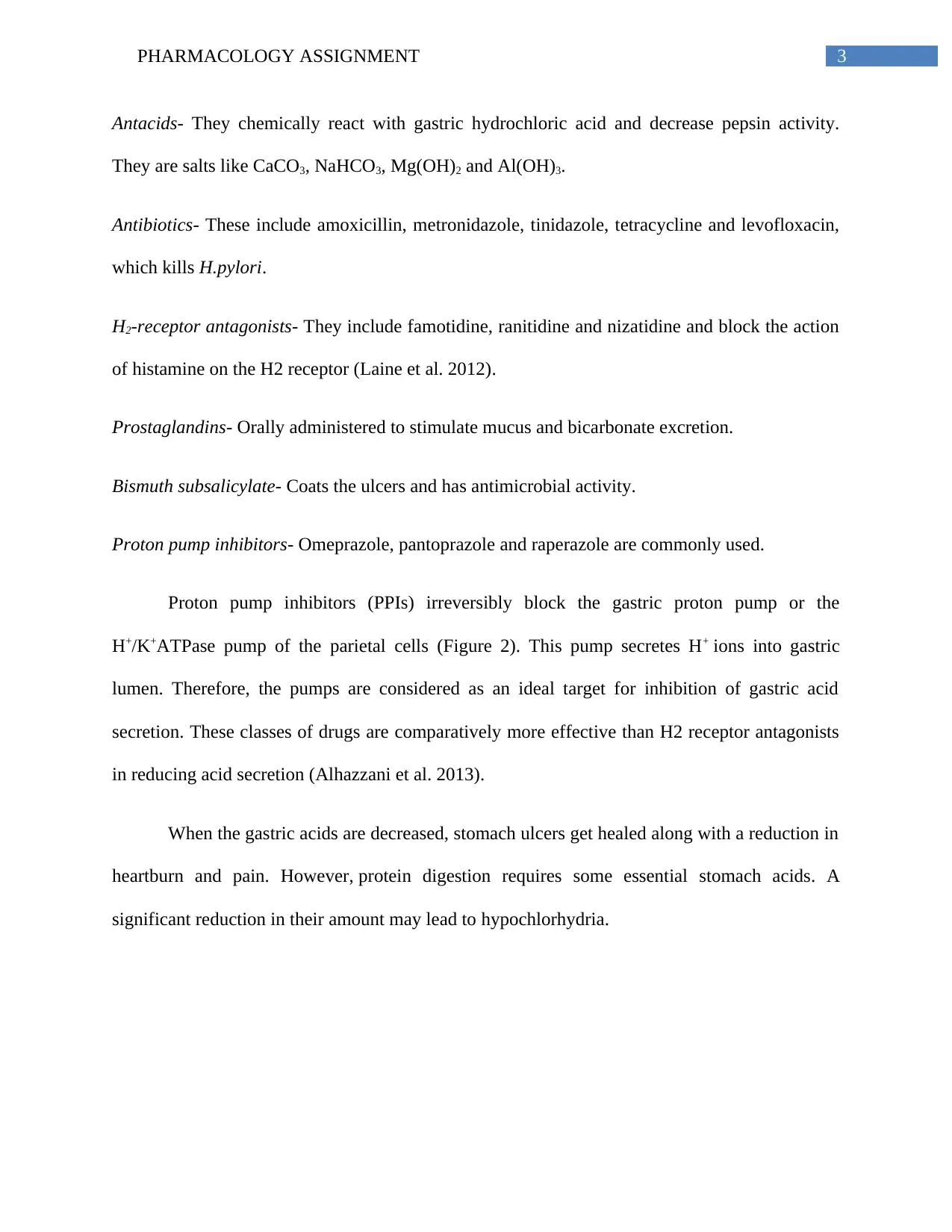
3PHARMACOLOGY ASSIGNMENT
Antacids- They chemically react with gastric hydrochloric acid and decrease pepsin activity.
They are salts like CaCO3, NaHCO3, Mg(OH)2 and Al(OH)3.
Antibiotics- These include amoxicillin, metronidazole, tinidazole, tetracycline and levofloxacin,
which kills H.pylori.
H2-receptor antagonists- They include famotidine, ranitidine and nizatidine and block the action
of histamine on the H2 receptor (Laine et al. 2012).
Prostaglandins- Orally administered to stimulate mucus and bicarbonate excretion.
Bismuth subsalicylate- Coats the ulcers and has antimicrobial activity.
Proton pump inhibitors- Omeprazole, pantoprazole and raperazole are commonly used.
Proton pump inhibitors (PPIs) irreversibly block the gastric proton pump or the
H+/K+ATPase pump of the parietal cells (Figure 2). This pump secretes H+ ions into gastric
lumen. Therefore, the pumps are considered as an ideal target for inhibition of gastric acid
secretion. These classes of drugs are comparatively more effective than H2 receptor antagonists
in reducing acid secretion (Alhazzani et al. 2013).
When the gastric acids are decreased, stomach ulcers get healed along with a reduction in
heartburn and pain. However, protein digestion requires some essential stomach acids. A
significant reduction in their amount may lead to hypochlorhydria.
Antacids- They chemically react with gastric hydrochloric acid and decrease pepsin activity.
They are salts like CaCO3, NaHCO3, Mg(OH)2 and Al(OH)3.
Antibiotics- These include amoxicillin, metronidazole, tinidazole, tetracycline and levofloxacin,
which kills H.pylori.
H2-receptor antagonists- They include famotidine, ranitidine and nizatidine and block the action
of histamine on the H2 receptor (Laine et al. 2012).
Prostaglandins- Orally administered to stimulate mucus and bicarbonate excretion.
Bismuth subsalicylate- Coats the ulcers and has antimicrobial activity.
Proton pump inhibitors- Omeprazole, pantoprazole and raperazole are commonly used.
Proton pump inhibitors (PPIs) irreversibly block the gastric proton pump or the
H+/K+ATPase pump of the parietal cells (Figure 2). This pump secretes H+ ions into gastric
lumen. Therefore, the pumps are considered as an ideal target for inhibition of gastric acid
secretion. These classes of drugs are comparatively more effective than H2 receptor antagonists
in reducing acid secretion (Alhazzani et al. 2013).
When the gastric acids are decreased, stomach ulcers get healed along with a reduction in
heartburn and pain. However, protein digestion requires some essential stomach acids. A
significant reduction in their amount may lead to hypochlorhydria.
Paraphrase This Document
Need a fresh take? Get an instant paraphrase of this document with our AI Paraphraser
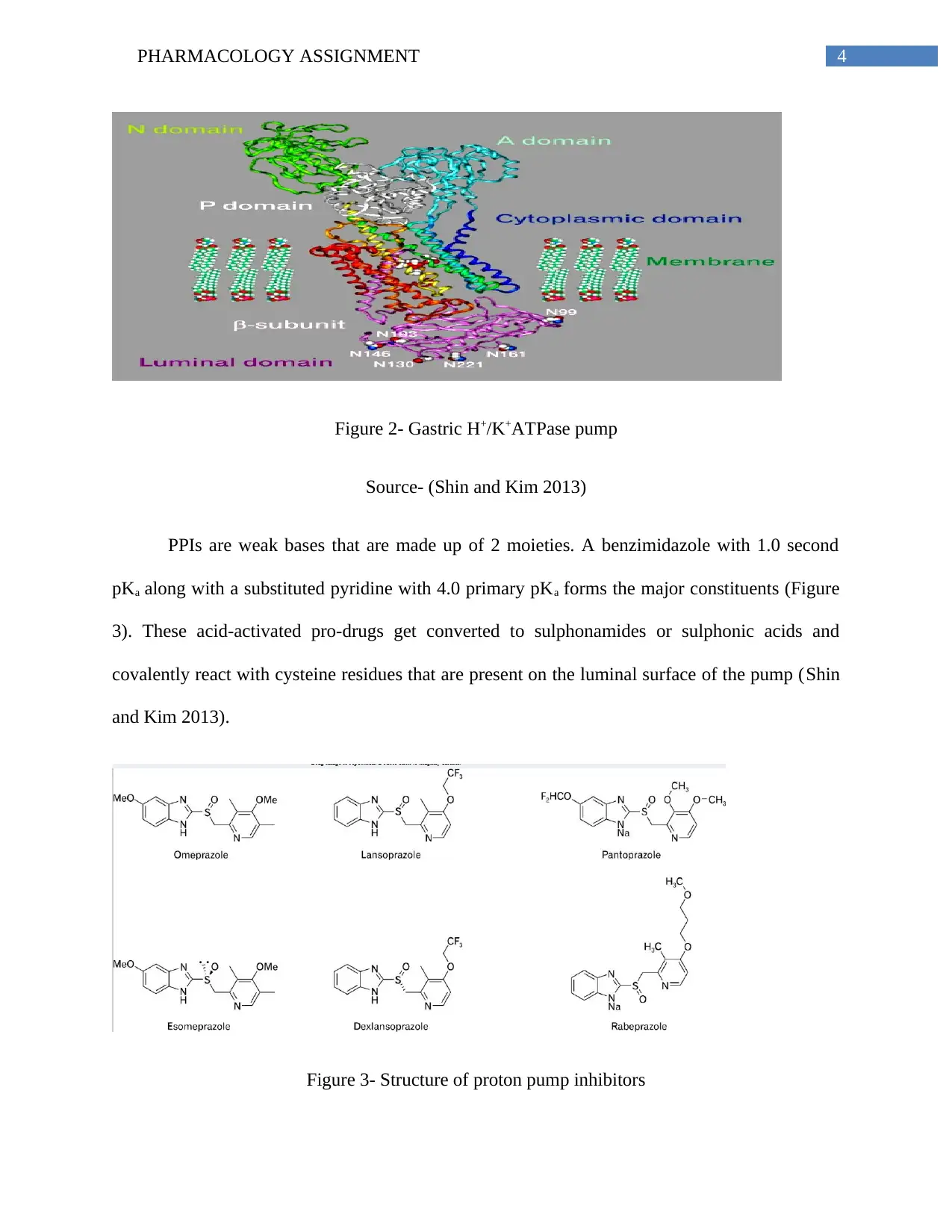
4PHARMACOLOGY ASSIGNMENT
Figure 2- Gastric H+/K+ATPase pump
Source- (Shin and Kim 2013)
PPIs are weak bases that are made up of 2 moieties. A benzimidazole with 1.0 second
pKa along with a substituted pyridine with 4.0 primary pKa forms the major constituents (Figure
3). These acid-activated pro-drugs get converted to sulphonamides or sulphonic acids and
covalently react with cysteine residues that are present on the luminal surface of the pump (Shin
and Kim 2013).
Figure 3- Structure of proton pump inhibitors
Figure 2- Gastric H+/K+ATPase pump
Source- (Shin and Kim 2013)
PPIs are weak bases that are made up of 2 moieties. A benzimidazole with 1.0 second
pKa along with a substituted pyridine with 4.0 primary pKa forms the major constituents (Figure
3). These acid-activated pro-drugs get converted to sulphonamides or sulphonic acids and
covalently react with cysteine residues that are present on the luminal surface of the pump (Shin
and Kim 2013).
Figure 3- Structure of proton pump inhibitors
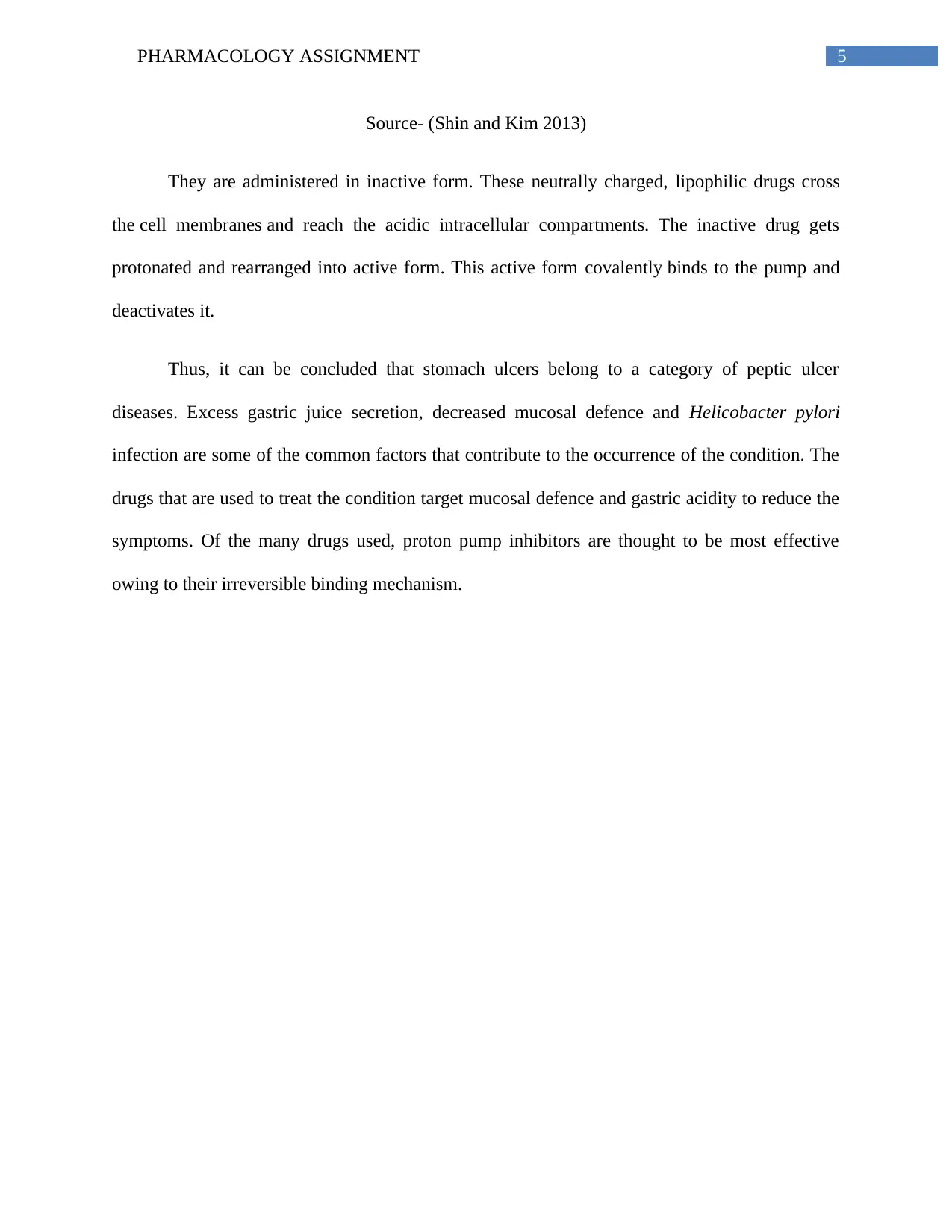
5PHARMACOLOGY ASSIGNMENT
Source- (Shin and Kim 2013)
They are administered in inactive form. These neutrally charged, lipophilic drugs cross
the cell membranes and reach the acidic intracellular compartments. The inactive drug gets
protonated and rearranged into active form. This active form covalently binds to the pump and
deactivates it.
Thus, it can be concluded that stomach ulcers belong to a category of peptic ulcer
diseases. Excess gastric juice secretion, decreased mucosal defence and Helicobacter pylori
infection are some of the common factors that contribute to the occurrence of the condition. The
drugs that are used to treat the condition target mucosal defence and gastric acidity to reduce the
symptoms. Of the many drugs used, proton pump inhibitors are thought to be most effective
owing to their irreversible binding mechanism.
Source- (Shin and Kim 2013)
They are administered in inactive form. These neutrally charged, lipophilic drugs cross
the cell membranes and reach the acidic intracellular compartments. The inactive drug gets
protonated and rearranged into active form. This active form covalently binds to the pump and
deactivates it.
Thus, it can be concluded that stomach ulcers belong to a category of peptic ulcer
diseases. Excess gastric juice secretion, decreased mucosal defence and Helicobacter pylori
infection are some of the common factors that contribute to the occurrence of the condition. The
drugs that are used to treat the condition target mucosal defence and gastric acidity to reduce the
symptoms. Of the many drugs used, proton pump inhibitors are thought to be most effective
owing to their irreversible binding mechanism.
⊘ This is a preview!⊘
Do you want full access?
Subscribe today to unlock all pages.

Trusted by 1+ million students worldwide
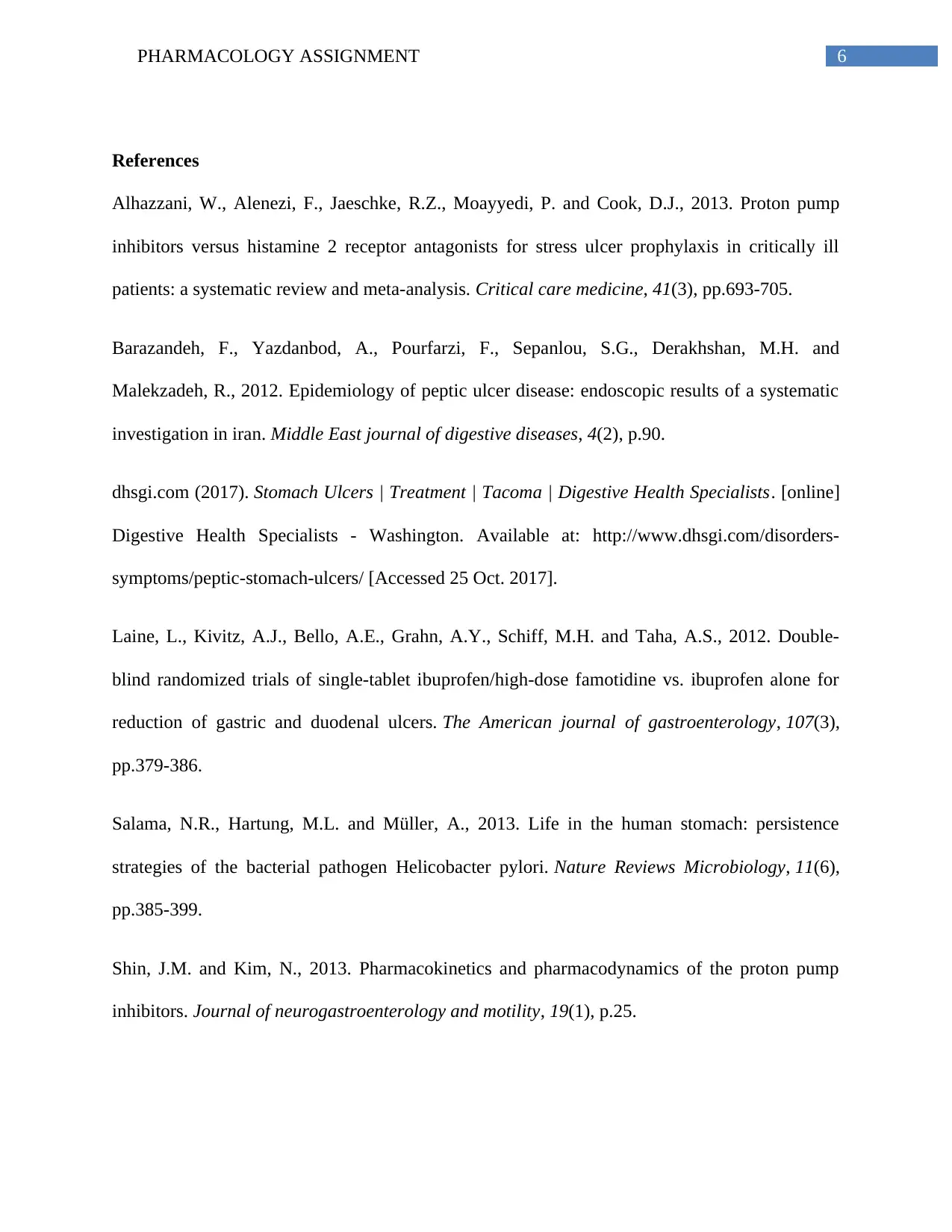
6PHARMACOLOGY ASSIGNMENT
References
Alhazzani, W., Alenezi, F., Jaeschke, R.Z., Moayyedi, P. and Cook, D.J., 2013. Proton pump
inhibitors versus histamine 2 receptor antagonists for stress ulcer prophylaxis in critically ill
patients: a systematic review and meta-analysis. Critical care medicine, 41(3), pp.693-705.
Barazandeh, F., Yazdanbod, A., Pourfarzi, F., Sepanlou, S.G., Derakhshan, M.H. and
Malekzadeh, R., 2012. Epidemiology of peptic ulcer disease: endoscopic results of a systematic
investigation in iran. Middle East journal of digestive diseases, 4(2), p.90.
dhsgi.com (2017). Stomach Ulcers | Treatment | Tacoma | Digestive Health Specialists. [online]
Digestive Health Specialists - Washington. Available at: http://www.dhsgi.com/disorders-
symptoms/peptic-stomach-ulcers/ [Accessed 25 Oct. 2017].
Laine, L., Kivitz, A.J., Bello, A.E., Grahn, A.Y., Schiff, M.H. and Taha, A.S., 2012. Double-
blind randomized trials of single-tablet ibuprofen/high-dose famotidine vs. ibuprofen alone for
reduction of gastric and duodenal ulcers. The American journal of gastroenterology, 107(3),
pp.379-386.
Salama, N.R., Hartung, M.L. and Müller, A., 2013. Life in the human stomach: persistence
strategies of the bacterial pathogen Helicobacter pylori. Nature Reviews Microbiology, 11(6),
pp.385-399.
Shin, J.M. and Kim, N., 2013. Pharmacokinetics and pharmacodynamics of the proton pump
inhibitors. Journal of neurogastroenterology and motility, 19(1), p.25.
References
Alhazzani, W., Alenezi, F., Jaeschke, R.Z., Moayyedi, P. and Cook, D.J., 2013. Proton pump
inhibitors versus histamine 2 receptor antagonists for stress ulcer prophylaxis in critically ill
patients: a systematic review and meta-analysis. Critical care medicine, 41(3), pp.693-705.
Barazandeh, F., Yazdanbod, A., Pourfarzi, F., Sepanlou, S.G., Derakhshan, M.H. and
Malekzadeh, R., 2012. Epidemiology of peptic ulcer disease: endoscopic results of a systematic
investigation in iran. Middle East journal of digestive diseases, 4(2), p.90.
dhsgi.com (2017). Stomach Ulcers | Treatment | Tacoma | Digestive Health Specialists. [online]
Digestive Health Specialists - Washington. Available at: http://www.dhsgi.com/disorders-
symptoms/peptic-stomach-ulcers/ [Accessed 25 Oct. 2017].
Laine, L., Kivitz, A.J., Bello, A.E., Grahn, A.Y., Schiff, M.H. and Taha, A.S., 2012. Double-
blind randomized trials of single-tablet ibuprofen/high-dose famotidine vs. ibuprofen alone for
reduction of gastric and duodenal ulcers. The American journal of gastroenterology, 107(3),
pp.379-386.
Salama, N.R., Hartung, M.L. and Müller, A., 2013. Life in the human stomach: persistence
strategies of the bacterial pathogen Helicobacter pylori. Nature Reviews Microbiology, 11(6),
pp.385-399.
Shin, J.M. and Kim, N., 2013. Pharmacokinetics and pharmacodynamics of the proton pump
inhibitors. Journal of neurogastroenterology and motility, 19(1), p.25.
1 out of 7
Related Documents
Your All-in-One AI-Powered Toolkit for Academic Success.
+13062052269
info@desklib.com
Available 24*7 on WhatsApp / Email
![[object Object]](/_next/static/media/star-bottom.7253800d.svg)
Unlock your academic potential
Copyright © 2020–2025 A2Z Services. All Rights Reserved. Developed and managed by ZUCOL.





